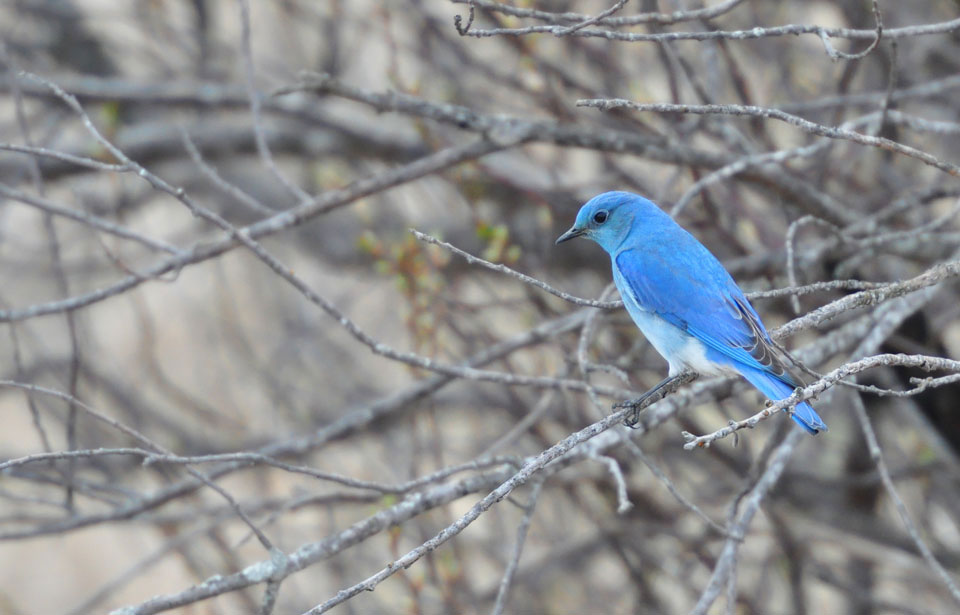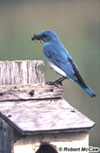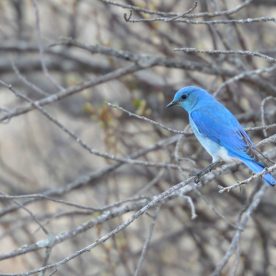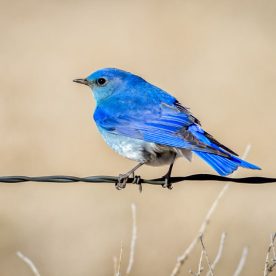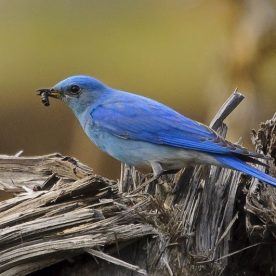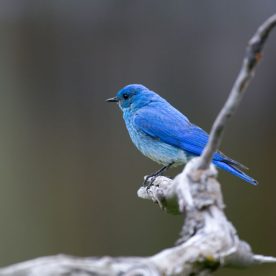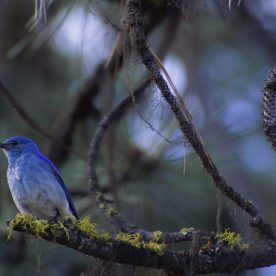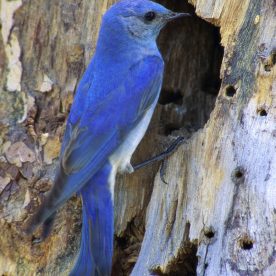Description
Three species of bluebird are found in North America: the Mountain Bluebird Sialia currucoides, the Eastern Bluebird Sialia sialis, and the Western Bluebird Sialia mexicana.
Bluebirds belong to the thrush family, whose members are found throughout much of the world. Another of North America’s well-loved birds, the American Robin, is also a thrush.
The Mountain Bluebird is a little larger than a House Sparrow but smaller than an American Robin. The back, wings, and tail of the male are a bright azure-blue, and the throat and breast are a lighter blue, which fades to white on the abdomen.
On the female, the flight feathers and tail are pale blue and the head and back are a mixed wash of blue and grey. The throat is brownish-ash, blending to white on the lower breast. Immature birds resemble females, except for the mottled breast characteristic of all juvenile members of the thrush family.
Signs and sounds
After working the fence line for some time, the Mountain Bluebird may disappear over the next ridge or clump of trees, leaving behind a soft warbling song. It has a louder song, which is heard most often in pre-dawn hours, during the breeding season.
Habitat and Habits
The Mountain Bluebird’s preferred habitat is sparsely treed grasslands. They require cavities for nesting. During winter, Mountain Bluebirds travel in flocks, often with Western Bluebirds and Sparrows, and feed on insects and small fruit, such as mistletoe, hackberry, and currants. They typically begin to move north in March, but often arrive in northern latitudes when snow still blankets much of the ground and temperatures still dip below -20°C. These hardy birds can usually withstand short spells of cold and stormy weather; however, during prolonged severe conditions they may freeze or starve to death.
Mountain Bluebirds sometimes migrate alone but more often travel in flocks of up to 50 birds (rarely up to 200). They travel during the day at a leisurely pace, stopping frequently to feed. They can sometimes be seen strung like brilliant blue jewels along a barbed wire fence, scanning bare patches of ground for weed seeds and dead insects. Highly aggressive birds, they usually sit at least a metre apart. There is a continual flashing of blue, as first one and then another leaves its perch momentarily to pick up a tasty morsel.
Unique characteristics
When elevated perches are not available, the Mountain Bluebird, unlike other members of the thrush family, will obtain most of its food by hovering in the air a metre or more above the ground in a hawk-like manner, as it searches the earth below for food.
Range
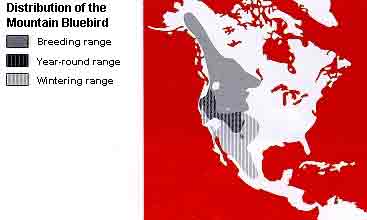
The Mountain Bluebird inhabits western North America. Its breeding range extends from the Yukon Territory, south through British Columbia east of the Coast Range. It breeds as far east as eastern Manitoba.
The Mountain Bluebird is the most migratory bluebird species, although many individuals simply move locally to southern elevations.
As for other bluebirds, the Eastern Bluebird, with its deep sky-blue back and crown and chestnut-red throat and breast, is found from southern Saskatchewan to Nova Scotia, along the east coast to Florida, and around the Gulf of Mexico to western Texas. The Western Bluebird, which is characterized by a blue throat and rusty upper back and breast, shares some of the Mountain Bluebird’s range in southwestern Canada. It occupies southern British Columbia through southern California into central Mexico and northward up through New Mexico to western Montana. It is scarcer than the Mountain Bluebird, except west of the coast ranges.
Feeding
Like other thrushes, Mountain Bluebirds are ground-feeders and eat mostly insects. Where elevated perches are not readily available, particularly near nest sites, the Mountain Bluebird will obtain most of its food by hovering in the air a metre or more above the ground in a hawk-like manner, as it searches the earth below for food. Other members of the thrush family do not use this hovering technique.
Breeding
Before the tail end of the migration has passed through, resident Mountain Bluebirds have fanned out over areas with suitable nesting habitat. Sparsely treed grasslands, wooded ravines and valleys, badlands, and mountains all meet the nesting requirements of Mountain Bluebirds, but they tend to avoid treeless plains.
The males often arrive first, and waste little time in searching out suitable nesting sites: woodpecker excavations and decayed cavities in trees are used where available. In the treeless badlands, bluebirds nest in cracks and crevices of steep eroding hillsides. In built-up areas, they move into machinery, nooks and crannies in buildings, fence-posts, and utility poles. Recently, the birdhouse has become an important nesting site.
Once the male has found cavities to his liking, he entices a prospective mate to inspect them. The male goes in and out of each cavity, fluttering excitedly about the female and calling continually, all in an effort to have her accept the site. This exuberant display may last, off and on, for hours or even days, until a female finally condescends to try out the cavity for size. She decides whether to accept or reject the site.
After a nest site is agreed upon, both birds defend the immediate area. The female builds the nest of dry grass stems and finer plant material, including thin strips of soft bark, while the male oversees her activities and guards against intruders. This process may take anywhere from two days to more than a week.
Soon after completing the nest, the female lays one egg each day until the clutch, usually with five or six eggs, is complete. Occasionally there are up to eight eggs in a clutch.
Incubation, or warming of the eggs until they hatch, starts after the final egg is laid and lasts for approximately 13 days. Only the female performs this task. She sits on the eggs all night and most of the day, leaving the nest briefly to feed. Occasionally, the male brings food to his mate.
After the eggs hatch, the blind, naked, and helpless fledglings must be fed. The female spends much of her time the first week brooding, or sitting on the young birds to keep them warm, and feeding them with food delivered by the male. On a diet of insects, including beetles, cutworms, and grasshoppers, the fledglings grow rapidly, doubling their body weight two or three times during the first week of life. The young birds’ droppings come encased in a sac that can be carried away by the adults, so the nest remains clean for the first week or two. At 14 days of age the tiny bodies are nearly completely feathered, and the young leave the nest at about 18 to 21 days, although the timing of fledging is quite variable. Bluebirds are able to fly about 100 m on their first rather haphazard flight.
The young are wholly dependent for about three days, and may not be fully independent until two months later. Approximately half of adult pairs prepare a nest for a second brood. This is usually built in the same cavity. The second clutch of eggs is about one egg smaller than the first. If the eggs or young of any brood are destroyed by predators, the bluebirds will avoid the nesting site for the rest of the season and may move as much as 200 km to establish a new nest site.
Groups of one or more families and other individuals remain in the area throughout the summer and autumn until cold weather drives them south for another winter.
Conservation
Bluebirds probably were never common, as they were limited by their nesting requirements. However, in the 1800s as colonists spread out across North America and cleared heavily wooded areas, bluebird habitat increased. The settlers also controlled prairie fires, which allowed more trees to mature and develop nesting cavities.
In the early 1900s, the bluebird’s future looked promising. But this era of good fortune was short-lived: more settlers arrived, land became more valuable, and many thousands of hectares of bluebird habitat were completely denuded of trees annually for farming. Also, Europeans brought with them intruders—starlings and House Sparrows—which had little difficulty in evicting the bluebirds from the few remaining nest sites.

Sialia currucoides
Photo: USFWS/Dave Menke
Bluebird numbers continued to decline until some naturalists felt the bluebird was doomed to extinction. Fortunately, bird lovers across North America began in the 1920s to build bluebird nest boxes in an attempt to reverse the decline. This conservation effort really became popular during the 1950s and 1960s. The results have been encouraging.
Today, humans still compete for habitat with bluebirds. Forestry practices that remove dead trees and snags reduce the available nesting cavities for bluebirds. Some people have helped to offset this loss by creating trails of bluebird nest boxes. Unfortunately, sometimes other people vandalize nest boxes and destroy their contents.
Although bluebirds tend to arrive early enough in spring to get first choice of the available nest boxes, they must sometimes compete for them with Tree Swallows, House Wrens, chickadees, House Sparrows, and European Starlings. Starlings can be excluded from the competition by an entrance hole no larger than 3.8 cm in diameter. In addition, each of the three bluebird species competes with the others for boxes, where ranges overlap.
Once installed, bluebirds are well able to defend boxes that are properly designed and placed to their liking. However, where House Sparrows are abundant they may enter a bluebird box and go so far as to kill young and adult bluebirds. Although it is too large to enter their nest boxes, the main avian predator of the bluebird is the American Kestrel, a small hawk.
Domestic cats and raccoons are formidable predators of young and incubating female bluebirds. Deer mice and chipmunks can also be problems. Smooth metal posts will often prevent animals from climbing up to nest boxes.
A parasitic blowfly Apaulina stalia takes its toll of bluebirds in some areas, although it is not thought to reduce population size. The fly lays its eggs in the bird’s nest, and the larvae attach themselves to the young birds and may kill them by sucking their blood. This parasite can be controlled by dusting nest boxes with diatomaceous earth.
As a result of bluebird banding programs, we now know that some bluebirds nest when they are one year old. The age record for a Mountain Bluebird is four years and 10 months, and an Eastern Bluebird lived eight years. Banding has also shown that successful breeders often return to the same area or nest site each year.
Contrary to popular belief, very few young bluebirds return to nest in the area in which they were raised. In one study area, less than one percent of the young fledged were found nesting in that area in subsequent years. Probably, many do not survive to breed, and survivors disperse to new areas.
The erection of thousands of birdhouses by concerned individuals and organizations has been responsible for preventing further depletion of bluebird numbers and in many areas has increased populations. Bluebird nest boxes need not be fancy; wood is the best material to use.
An ideal nest box for bluebirds would have a floor 20 cm square, walls 25 cm high, with a 3.8 cm diameter entrance hole located 18 cm above the floor.
The top of the birdhouse should be easily opened for cleaning. It should overhang the entrance hole to provide protection from rain.
Two 6-mm holes should be drilled near the top of each side for ventilation and two 6-mm holes should be made in the floor for drainage.
Perches should not be placed on the birdhouse, as they only encourage House Sparrows to take up residence.
If an exterior finish is desired to preserve the wood, a woodstain is adequate. If houses are painted, a light green, brown, or grey should be used. White is too conspicuous, and a white nest box is often shunned by bluebirds. Dark colors absorb heat, which may become too intense for the eggs or young in the nest box. Do not paint or varnish the inside of the box. The interior walls should have a rough surface to aid the bird in climbing up to the entrance hole.
The location of a bluebird house is important. Houses should be placed in semi-open areas such as pastures, fields, and rural roadsides. A fence post in a clearing with scattered trees about 20 m away is probably a good location. Bird houses in urban areas or near farm buildings are usually occupied by house sparrows.
The nest box should be placed on a post 1 m or more above the ground. It does not matter which direction the front of the house faces.
A “bluebird trail” consists of several nest boxes spaced 200 m or more apart and in a manner convenient for inspection on foot or by car, to record nesting success, band young birds, and clean out boxes in the fall. Regular inspections also allow the nest caretaker to remove nests of House Sparrows and other intruders. Some trails may be only a kilometre long, while the longest runs several hundred kilometres from Winnipeg, Manitoba, to North Battleford, Saskatchewan, with hundreds of kilometres of branch lines leading off from the main trail.
Resources
Online resources
Bird Studies Canada, Mountain Bluebird
All About Birds, Mountain Bluebird
Audubon Field Guide, Mountain Bluebird
Print resources
Bent, A. C. 1964. Life histories of North American thrushes, kinglets, and their allies. Dover Publications Inc., New York.
Godfrey, W. E. 1986. The birds of Canada. Revised edition. National Museums of Canada, Ottawa.
Peterson, R.T. 1961. A field guide to western birds. Second edition. Houghton Mifflin Inc., Boston.
Power, H.W., and M.P. Lombardo. 1996. Mountain Bluebird, Sialia currucoides. In Birds of North America, no. 222. A. Poole and F. Gill, editors. Academy of Natural Sciences, Phildelphia, and American Ornithological Union, Washington, D.C.
Terres, John K., editor. 1980. The Audubon Society Encyclopedia of North American Birds. Alfred A. Knopf, New York.
© Her Majesty the Queen in Right of Canada, represented by the Minister of the Environment, 1979, 1996. All rights reserved.
Catalogue number CW69-4/62-1996E
ISBN 0-662-24176-2
Text: Lorne Scott
Revision: Judith Kennedy and Erica Dunn, 1996
Photo: Robert McCaw



